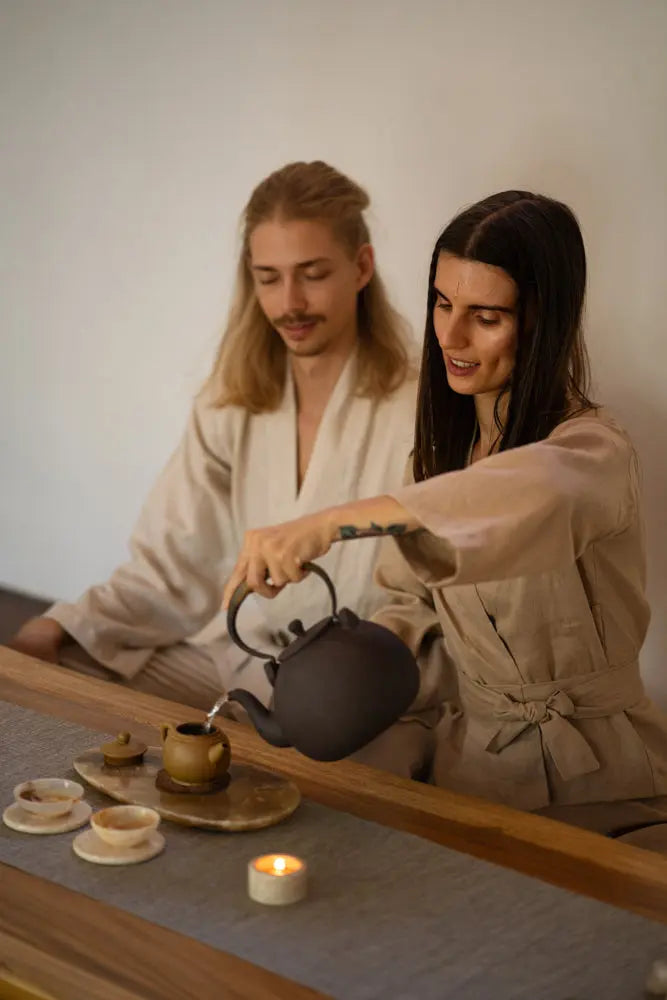
Chaxi in Cha Dao: Honouring the Sacred Communion Over Tea
Share
In the realm of Cha Dao — the Way of Tea — there is a beautiful term called "Chaxi". Derived from Chinese culture, Chaxi represents the ceremonial space and time dedicated to tea and all it encompasses. In Cha Dao, Chaxi serves as the setting for the tea ceremony, an experience that transcends the boundaries of culture, language, and time. The concept of Chaxi is both comprehensive and specific, viewed in a broad scope and in a precise approach.
Chaxi: A Celebration of Tea
At its heart, Chaxi is a whole tea 'ceremony' or 'session'. It is a tribute to the traditions, rituals, and the reverence for the venerable leaf that transforms into a divine nectar with an unending spectrum of chi (energy), flavors and aromas. The Chaxi incorporates the cleaning of ourselves and the tea space, the preparation and decoration of the tea space and table, preparation and serving of tea, enjoyment and experience of the tea itself, and finally, cleaning up after the ceremony.
In a more confined sense, Chaxi is the tea stage. The tea table is designed in a way to honour tea as a focal point of the tea ceremony. Yet, Chaxi is more than just a physical stage — it is a spiritual platform that houses the tea and everything it signifies.
The Ritual of Cleaning and Preparing
One of the primary practices associated with Chaxi is the ritual of cleaning and resetting the space. Before each ceremony, it is recommended to clean the entire tea space. In this tradition, it is often said that 80 per cent of the tea ceremony is cleaning. Tea itself used to be known as the Tree of Purification. This act of cleansing is symbolic of our intention to approach the ceremony with a clear, calm, and receptive mind.
Every item we place in this now pristine space is chosen deliberately, each bearing a specific purpose and meaning. The tea wares, the tea selection, and every object added to the stage is thoughtfully chosen, honouring both the tea and the guests who partake in the ceremony.
After the ceremony, it is recommended to practice removing all objects and placing them back onto the shelves or back to nature to create a blank canvas. In this way, the space is ready for the next tea ceremony and provides an opportunity to start fresh and honour the next occasion. The cyclical nature of this ritual helps refine our sense of aesthetics and deepen our understanding of simplicity.
The Aesthetics of Simplicity
Over time, we may find that fewer objects create a more coherent, focused space. In essence, the tea ceremony invites simplicity. We begin to consider each item's contribution to the experience, removing those that distract or detract from the focal point — the tea itself. This minimalistic approach reflects the essence of tea, simplicity, and the harmony it shares with nature.
Honouring Occasions and Themes
Chaxi is often utilized to celebrate occasions, each time honouring a unique theme. The selected items for one session may not be relevant for another, and this reinforces the intentional selection and placement of every piece in the Chaxi.
Chaxi: An Expression of Awareness and Being
More than just a physical setting, Chaxi reflects our state of being and awareness. It is the stage upon which we may arrange meaningful objects such as stones, crystals, flowers, or deities. These objects aren't mere decorations, but symbolic expressions that contribute to the occasion being celebrated.
The Practice of Tea and Life
In the tradition of Cha Dao, the practice of tea goes beyond just brewing and drinking. It influences all aspects of our lives. It involves our state of mind, self-cultivation, cleaning, fetching water, preparing coals for fire, arranging flowers, and so on. The qualities of a tea person are cultivated in all areas of life, and our overall state of being influences the tea we prepare.
The Ultimate Goal of Chaxi
Contrary to what one might think, the goal of the Chaxi is not a direct expression of our personal style or preferences. The ultimate aim is to create a harmonious setting that honours the communion between Nature and people over tea. It's a chance to create an atmosphere that encourages presence, reverence, and a deep appreciation for the fleeting beauty of moments shared over tea.
In conclusion, Chaxi in Cha Dao is an art form within our meditative practice, and a philosophy that enriches our understanding of life. As we prepare and enjoy tea in an intentional space, we're invited to connect with our inner selves, with others, and with the intricate tapestry of nature that surrounds us. In essence, Chaxi is an embodiment of the soul of Cha Dao — the Way of Tea.
